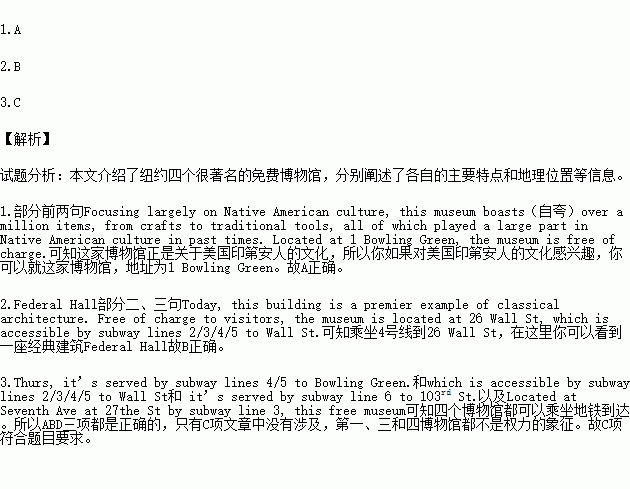题目内容
In New York there are quite a few free museums for visitors. Below we explore New York’s most impressive free ones.
National Museum of the American Indian
Focusing largely on Native American culture, this museum boasts(自夸)over a million items, from crafts to traditional tools, all of which played a large part in Native American culture in past times. Located at 1 Bowling Green, the museum is free of charge. Open 10 a.m.~5p.m. Frid-Wed and 10 a.m.~8 p.m. Thurs, it’s served by subway lines 4/5 to Bowling Green.
Federal Hall
A popular one for followers of American politics, Federal Hall is the original location of the US Customs House and the place where Washington took the oath(宣誓)of office in 1789 as the first US President. Today, this building is a premier example of classical architecture. Free of charge to visitors, the museum is located at 26 Wall St, which is accessible by subway lines 2/3/4/5 to Wall St. It’s open from 9 a.m.~ 5 p.m. Mon-Fri.
New York Academy of Medicine
For the more intellectual, a trip to the New York Academy of Medicine is unmissable. With over 700,000 catalogued works, it’s the world’s second largest health library. Its biggest attraction, however, is the interesting medical equipment on display here, which is weird(古怪的) but wonderfully original. Located at 1216 Fifth Ave at 103rd St, it’s free of charge to peruse. Open 9 a.m. ~ 5 p.m. Mon-Fri, it’s served by subway line 6 to 103rd St.
Museum at Fashion Institute of Technology
The museum contains a huge permanent collection which features 200 historically significant clothes and also features works by student exhibitions. With free talks and tours on offer, this museum is a great place without spending a cent. Located at Seventh Ave at 27the St by subway line 3, this free museum---undoubtedly the most fashionable one in New York --- is open Tues-Fri 12 a.m. ~8 p.m. and Sat 10 a.m.~ 5 p.m..
1.If you are interested in Native American culture, where would you probably go?
A. To 1 Bowling Green.
C. To 1216 Fifth Ave.
B. To Seventh Ave at 27th St.
D. To 103rd Wall St.
2.If you take the subway line 4 to 26 Wall St, you can enjoy __________. |
A. reading medical books
C. the art of costume
B. the art of architecture
D. the ancient tools
3.Which of the following about the four museums mentioned in the text is NOT true?
A. They are all located in New York.
C. They are all symbols of power.
B. They are all free of charge.
D. They are all accessible by subway.

